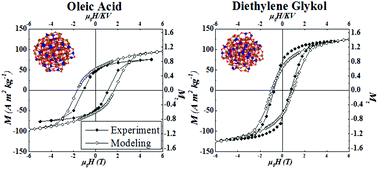Optimising the magnetic performance of Co ferrite nanoparticles via organic ligand capping†
Abstract
Ferrofluids of CoFe2O4 nanoparticles are gaining increasing interest due to their enhanced heating performance in biomedical applications (e.g. in magnetic hyperthermia as mediators for cancer treatment) or in energy applications (e.g. magneto-thermo-electric applications). Until now, the effect of an organic surfactant on the magnetic particle behaviour has been unintentionally overlooked. Here, we present the counterintuitive magnetic effect of two representative organic ligands: diethylene glycol (DEG) and oleic acid (OA) bonded at the surface of small (∼5 nm in size) CoFe2O4 particles. The combined results of the bulk dc susceptibility, local-probe Mössbauer spectroscopy and physical modelling, which is based on electronic structure calculations and Monte Carlo simulations, reveal the effect of different ionic distributions of the particles due to the different surfactant layers on their magnetic behaviour. They result in an unexpected increase of the saturation magnetisation and the blocking temperature, and a decrease of the coercive field of DEG coated CoFe2O4 nanoparticles. Our work provides a pathway for the production of colloidal assemblies of nanocrystals for the engineering of functional nano-materials.



 Please wait while we load your content...
Please wait while we load your content...